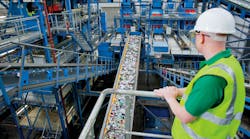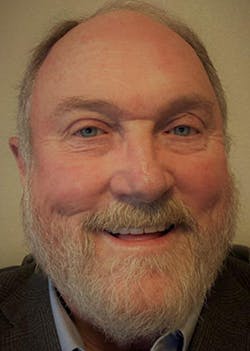David Frye, CMRP, CRL, is principal at Legacy TPM Partners, and has more than 45 years of experience with reliability, starting with U.S. Navy weapon systems and then working for 21½ years at Kodak. He then became corporate director for reliability and maintenance excellence at Kaiser Aluminum, and then spent 10 more years at Kimberly-Clark, helping to lead global reliability. Plant Services Editor in Chief Thomas Wilk spoke with David in a wide-ranging podcast interview soon after connecting at the RPM Symposium in Kalamazoo, MI.
PS: What are some of the favorite projects that you worked on, such as from the Navy or from Kimberly-Clark?
DF: Kimberly-Clark is the most recent one. And number one is global reliability, the concept of global reliability with Kimberly-Clark being kind of five major corporations under one roof; bringing that all together and having a reliability model was really big for me.
And then having the latitude to create an integrated deployment model that took what was maintenance in one camp and engineering in a different camp and operations in a different camp, and bringing them together under one integrated deployment model, and then having the opportunity to actually deploy that model. It sounded good on paper and made sense to me, but how does it work when you put it in motion? I had the chance being a deployment leader in the Latin America region, to actually play this model out, and was very, very happy with that.
A few other things that made a mark, that made a difference, was creating a lubrication network at Kimberly-Clark. At that time, we had 113 plants globally, and trying to get your head around lubrication is quite the challenge. We have started with North America and have a rep from each plant in North America, and I got them connected with the top vendors that are out there, the ones that I carefully vetted.
I also created a condition monitoring predictive maintenance network to bring some of the new technologies into Kimberly-Clark. One of the ones that I’m the most proud of is bringing ultrasound in as a technology to Kimberly-Clark. I also started a CRL network, a Certified Reliability Leader network. We had really smart people at Kimberly-Clark, no doubt about that, but did they know how to lead? Do they know how these systems all work? So I was the first Certified Reliability Leader or CRL at Kimberly-Clark, and when I left there were 97 CRLs. I’m pretty proud of that; that was big.
PS: That is amazing. We’ve noticed that leaders often don’t get that kind of formal training, that guidance to take the next step, even. They may get promoted and it may be years before they get any kind of formal leadership assistance or support like you’re talking about, so that’s fantastic.
DF: With the CRL, I did it just to do my due diligence. I wanted to bring something into Kimberly-Clark, and so I went to take a look at this five-day workshop and see what it was all about. The Uptime Elements that are in there give you a framework, it’s all the pieces you need, in nice and neat categories and descriptors of each one, and kind of show it all fits together. It doesn’t tell you how, but it tells you the what of all the pieces that you need. There’s quite a bit of examples in there on how to lead, so it was worth it.
After leaving Kimberly-Clark I actually retired, theoretically retired last April, but I’ve been working recently with a reliability startup called UpT Reliability Solutions out of Western Michigan, and that’s been a lot of fun. Getting them started and started on the right track, the right foot. I’m really happy with how that’s gone.
Why industrial plant teams need to embrace their creativity to achieve greater success
Why you should automate overall equipment effectiveness data collection
PS: A lot of the work you described is some pretty heavy lifting in terms of change management. The “people work” involved in reliability – you brought cross-functional teams together, you trained people to be leaders. Is there some part of that work that you’re specifically drawn to? Is it helping people realize what’s in themselves?
DF: You know how they used to say in politics, it’s the economy, stupid? Well, in reliability, it’s the people, stupid. It’s all about the people. The technology has been wrung out, it’s all artificial intelligence now, and manufacturing 4.0, that’s all taken over, and if you’ve got a checkbook big enough, you can just go buy it.
Everybody can buy the same technology, but you can’t buy the same culture and people, so it’s about empowering your employees, it’s about showing them, what’s in it for me? Why would they want to do this, and what’s in it for me? I’ve done a lot of stuff with all levels of the organization all the way from the boardroom, down to entry-level shop floor people, and there’s something in it for everybody in terms of reliability.
When I was with Kodak, I was trained by Shingijutsu senseis in Lean, I’ve got a pretty strong Lean background too, and I chose reliability. TPM reliability, I chose that. It’s the only initiative that I’m aware of, that will improve safety, quality, delivery, cost, and employee engagement – all five – with one initiative.
As a consultant, I go to plants all the time, and they’ve always got a safety department, they’ve always got a quality department, they’re always working on this stuff. They’re always sweating on-time delivery. And of course, they’re always worried about cost. And if they have time left over, they worry about the employees. Well, the employees are how you get this stuff, if you engage them from the beginning.
One of the slides that I showed at the RPM Symposium, and it’s one that’s kind of near and dear to me, and I learned this from the Japanese actually, is the concept of individual kaizen or individual improvement. The slide says, “What’s worth more? One $1,000,000 improvement, or 1,000,000 one-dollar improvements?” They’re both worth a million bucks. What’s easier to get? A million $1 improvements, or a $1,000,000 improvement?
The shop floor is full of one-dollar improvements. All you have to do is ask. We just need to be smart enough to listen to them. It’s all about the small improvements. And that’s where the culture piece comes in.
One thing I learned, and I’ve worked in well over 200 factories in my career, is that sometimes to bring a big change like this in, I always start out by interviewing and I talk to the people who are going to sign my paycheck, the executives, what do you want to get out of this? To make sure that it’s practical. Then I talk a little bit about the approach that I’ve crafted, and they always say, “well, that’s really great, but the union will never agree to that” or “the shop floor will never agree to that.”
Okay, well then, can I go talk to the shop floor and union leadership? So I go off in the corner and talk to them. I don’t bring them to me, I go to the floor and talk to them and say, what do you want to get out of this? “Well, we just want a better place to retire to dealing with the same problems over and over again.” Then I say, how about if we could get you involved and engaged and listen to what you’re saying? “Well, that’d be great. But management will never let us do that.”
So they both say exactly the same thing and they both want exactly the same thing. Sometimes middle leadership’s a little different, but the top and bottom, they want exactly the same thing: (1) they all want to be profitable, (2) they all want a safe place to work, (3) they all want continuity with their jobs, and (4) they want to make as much money as they can. They all do, top and bottom, and they all want the same thing.
I’ve gotten to where I won’t work on just technical things. If I can’t work with the culture, I’m not interested in the job, I won’t consult with you, I won’t help you. I know how to do these things, but I just won’t do it. And one thing I thought was interesting when I left Kimberly-Clark (and they had the Let’s Roast Dave Frye Zoom meeting, because we couldn’t meet because of COVID), the vice president of global supply chain said one thing different. He says, “Most people at Kimberly-Clark are known for the projects. They’re known for the big machines they bring in or starting up factories and things like that. You’re not known for any of that. Your footprints are much deeper because you’re known for helping people see what needs to be done and actually changing the culture, and your stuff will last a lot longer than any of these projects.”
Listen to the entire interview
This story originally appeared in the January 2022 issue of Plant Services. Subscribe to Plant Services here.

